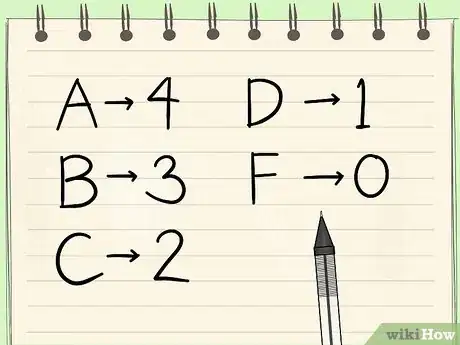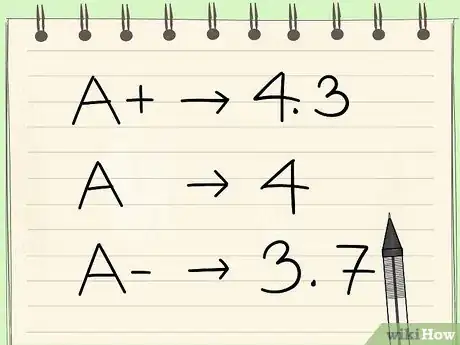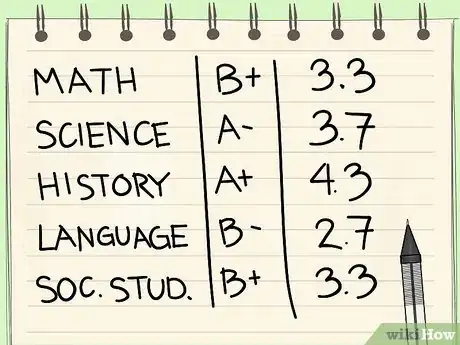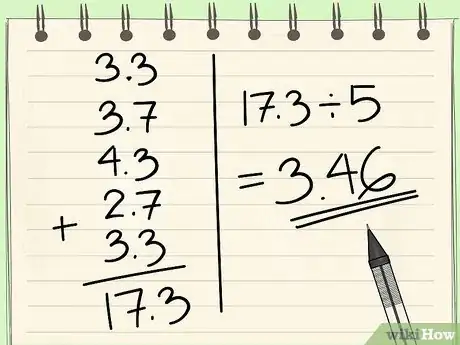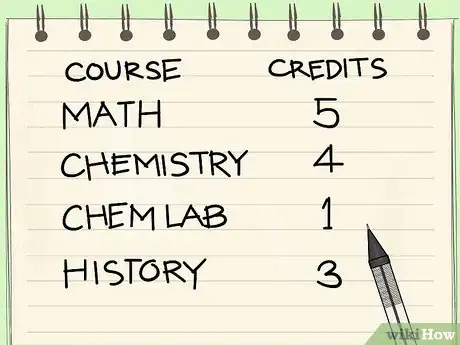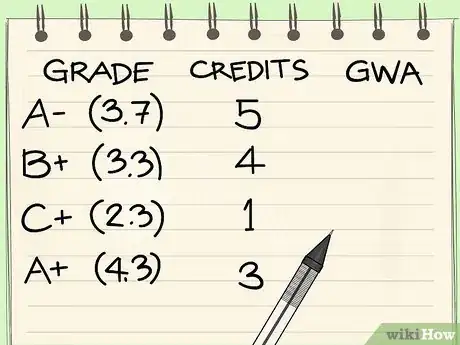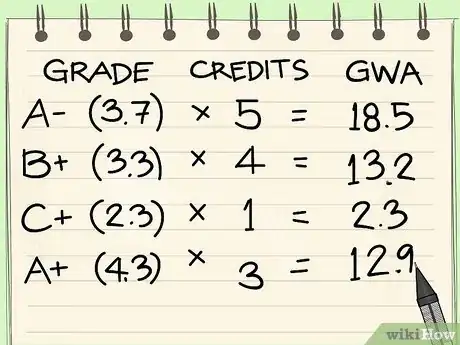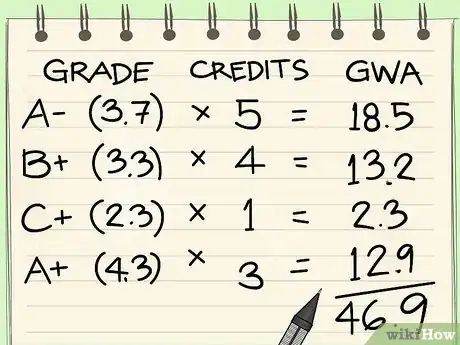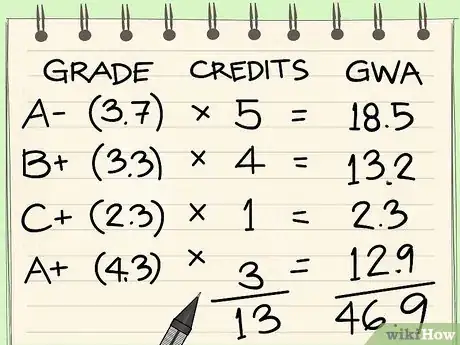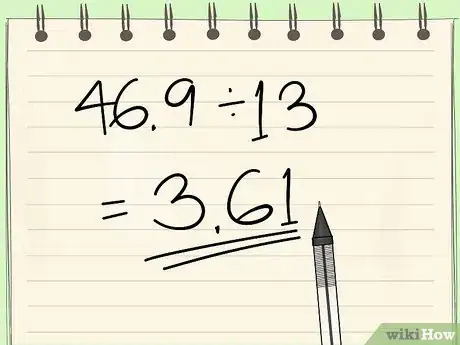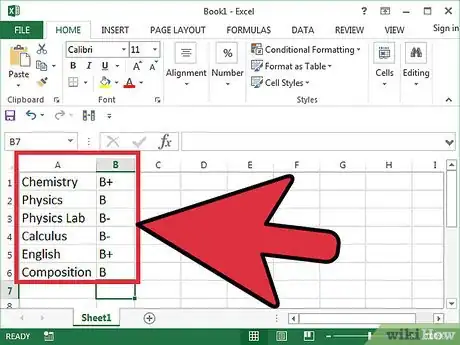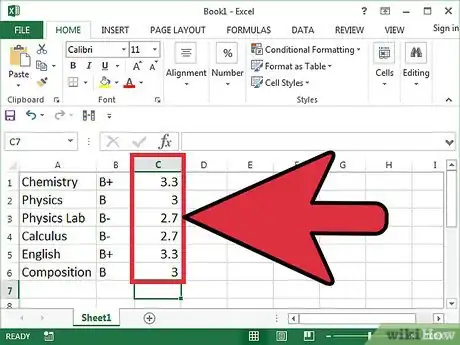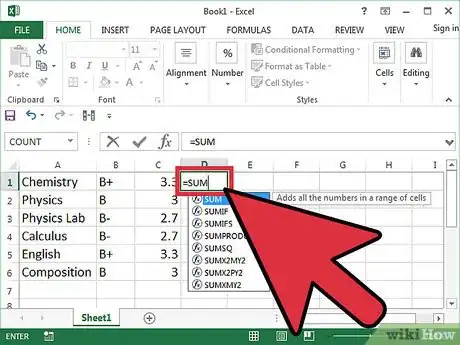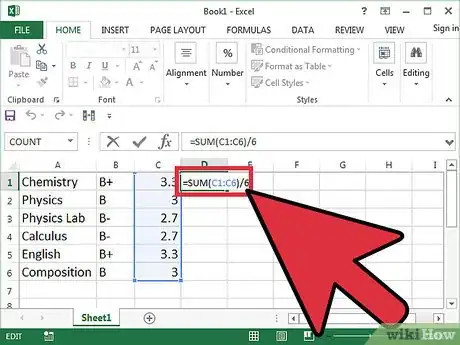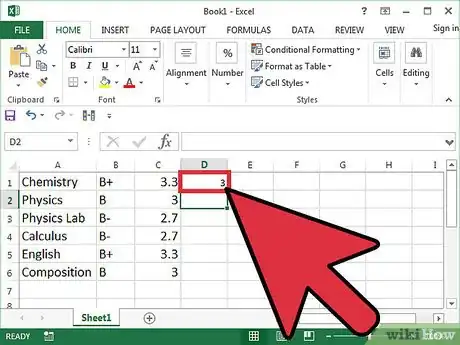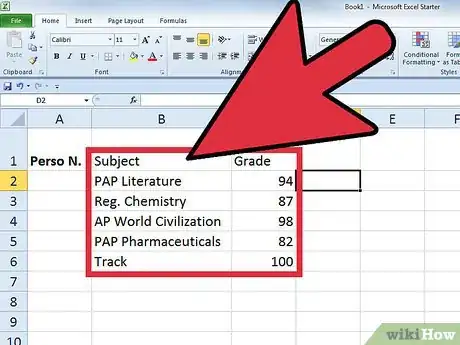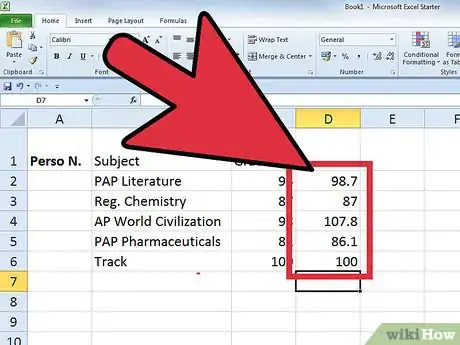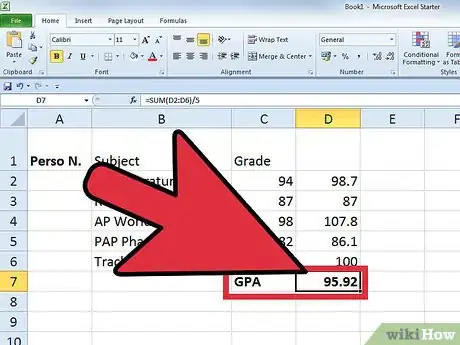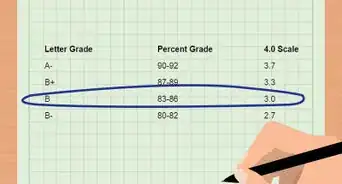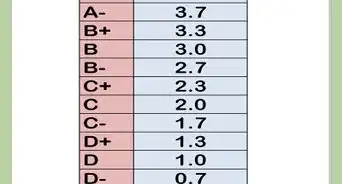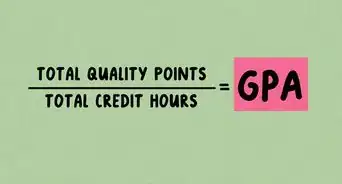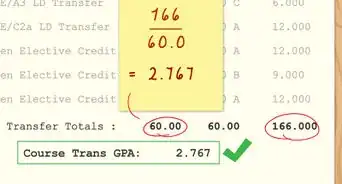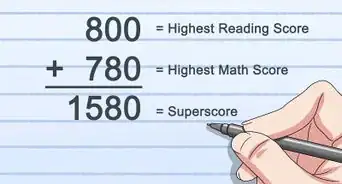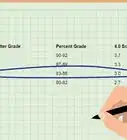This article was co-authored by Rachel Scoggins, PhD. Rachel Scoggins is a Visiting Assistant Professor of English at Lander University. Rachel's work has been presented at the South Atlantic Modern Language Association and the Georgia International Conference on Information Literacy. She received her PhD in Literary Studies from Georgia State University in 2016.
There are 8 references cited in this article, which can be found at the bottom of the page.
wikiHow marks an article as reader-approved once it receives enough positive feedback. In this case, several readers have written to tell us that this article was helpful to them, earning it our reader-approved status.
This article has been viewed 1,870,380 times.
Grade point average (GPA) is a raw score average based on the letter grades you make each semester. Each letter grade is assigned a numerical value from 0-4 or 5 points, depending on your institution's scale. Schools also look at cumulative GPAs, which show your average GPA over several years of schooling, when you graduate or apply to an institution of higher education. Unfortunately, there is no universal way to calculate GPA since methods vary by country and by institution, and some schools give extra points for honors classes or weigh scores by units. However, to calculate GPA, you'll basically need to find your grading scale, translate each letter grade to a corresponding numerical value within the scale, then average those values to find your current GPA. Note that you'll need to do a little extra math beyond that if any of your scores are weighted.
Steps
Using Simple GPA Calculation
-
1Find a grading scale. The most common grading scale for schools in the United States is a four-point scale. Using this scale, a grade of A = 4 points, B = 3 points, C = 2 points, D = 1 point, and F = 0 points. This is called an unweighted GPA. Some schools use a weighted GPA, which allots 5 points for more rigorous classes, such as honors, Advanced Placement (AP), and International Baccalaureate (IB). Other classes are weighted the same. Students who take the 5-point classes can end up with GPAs above a 4.0.[1]
- Some schools use plus and minus grading, which values a plus as +.3 and a minus as -.3. For instance, a B+ is worth 3.3, a B is worth 3.0, and a B- is worth 2.7 points.[2]
- If you’re unsure what your school uses, try asking your teacher or an administrator.
-
2Collect the most recent grades you can by asking your teacher, an office administrator, or registrar. You might also be able to figure out what grades you've received by going back over old report cards or transcripts.[3]
- You want to collect the final grades for each of your classes. Individual class grades, midterm grades, or grades on mid-semester report cards do not count. Only final grades for the semester, term, or quarter factor into your GPA.
Advertisement -
3Record the point value for each grade. Write down the correct point value next to each grade using the four-point scale. So, if you have an A- in a class, record a 3.7; if you have a C+, record a 2.3.[4]
- For easy reference, use this chart from the College Board to help assign the correct 4.0-scale value.
-
4
-
5
Calculating a GPA with Weighted Credit Hours
-
1Determine the number of credits. For some schools, especially college courses, each course has a number of credit hours. Credit hours are units schools use to measure the work load. Generally, credit hours are based on mode of instruction, number of hours spent inside the classroom, and number of hours spent studying outside the class. Find out the number of credit hours assigned to each course you are taking. It should be listed on your transcripts or in the school catalogue.[6]
- Some schools mostly offer 3 credit hour courses, other colleges 4 credit hour courses, and some schools do a mixture. For many schools, labs are 1 hour.
- If you cannot find the credit hours for each of your courses, talk to an administrator or the registrar.
-
2Assign the appropriate scale value for each letter grade. Use the common 4-point GPA scale to assign the values: A = 4 points, B = 3 points, C = 2 points, D = 1 point, and F = 0 points.[7]
- If your school allots 5 points for upper level classes, such as Advanced Placement (AP) or International Baccalaureate (IB), you will be using a weighted GPA scale.
- Add .3 for each plus value or subtract .3 for each minus value. If you have an A- in a class, mark it as 3.7. Match up each letter grade with its scale value and write it next to the grade (e.g. B+ = 3.3, B = 3.0, B- = 2.7).
-
3Calculate the weighted scores. To find the GPA, you must do a little bit of math to determine the different values for the scores that go into the overall GPA.[8]
- Multiply each scale value grade by the number of credit hours to get the grade points. For example, if you made a B in a 4 credit hour class, you would multiply the scale value of 3 for the B by 4 credit hours, which gives you 12 grade points for that class.
- Add the weighted grade points for all of your classes together to calculate your total grade points.
-
4Find your total weighted credits. Add together the number of credit hours you have taken in total to get the total credits. If you took 4 classes that were 3 credit hours each, you will have a total of 12 credit hours.[9]
-
5Divide the grade points total by the credit hours total. For example, if you have a total of 45.4 grade points in a total of 15.5 credit hours, you would have the following math problem: 45.4 / 15.5 = 2.92. Your credit hour-weighted GPA is 2.92.[10]
Calculating GPA Using Excel
-
1Set up your initial columns. In the A column, type in the names or numbers of the subjects you're taking. In the B column, type in the letter grades you want to factor into your GPA.[11]
-
2Input the scale values in column C. Determine the numerical scale values of the grades you are inputting. To complete this step, you will have to decide if your school uses a weighted or unweighted GPA scale.[12]
- The common 4-point GPA scale is as follows: A = 4 points, B = 3 points, C = 2 points, D = 1 point, and F = 0 points. If your school uses a weighted GPA scale, they allot 5 points for upper level classes. Ask an administrator, teacher, or registrar for this information. You can also look on your report card or final grade sheets.
- Add .3 for each plus value or subtract .3 for each minus value. For example, B+ = 3.3, B = 3.0, B- = 2.7.
-
3Type an equals sign (=) into the first cell of column D. All excel equations begin with an equals sign, so you should use one every time you do a new calculation.[13]
-
4Type the letters SUM. This will indicate to the program that it will be calculating a sum (adding) equation.
-
5Fill in your equation. The equation you will use to calculate your GPA will be determined by how many grades you have, but the basic format is =SUM(C1:C6)/6.[14]
- C1 is the cell number (C- column, 1-row) of the first grade in your column.
- The number on the right side of the colon should be the cell number of the final grade on your list.
- The number after the slash should be the total number of courses that you are calculating. In this case, 6 courses are being calculated. If you have 10 courses listed, you will replace the 6 with a 10.
-
6Press the Enter key. You should be greeted with a single number in the D column, which is your final calculated GPA.
Calculating Percentage Based GPA
- Some schools use a percentage based GPA instead of a 4.0 or 4.33 pointe scale. Here is how to find it.
-
1Know the kinds of classes you've got. Certain classes have weights which alter the 'strength' of the class. A regular (also called on-level) class is multiplied by 1, or left alone. A PAP (which stands for Pre-Advanced Placements which can also be called Honours) is multiplied by 1.05. An AP (Advanced Placement, also called College or College Level) is multiplied by 1.1.
- Let`s say a person N. has 5 classes, and these are his grades; PAP Literature=94, Regular Chemistry=87, AP World Civilizations=98, PAP Pharmaceuticals Training=82 and Track=100 (lf unspecified, assume regular).
-
2Multiply the grades according to their weight.
- PAP Literature had a 94 which gets multiplied by 1.05 for 98.7%AJ (AJ=adjusted). Chemistry and Track are regular classes so they are left at their grades, respectively 87 and 100. PAP Pharmaceuticals Training is 82, multiplied by 1.05 is 86.1%AJ, and AP World Civilizations` 98 gets multiplied by 1.1 for a 107.8%AJ.
-
3Find the mean or average. The formula is very simple; (g+g+g...)/#g, when g=grade. Or in words, add the grades and divide by the number of grades added together.
- So 98.7+87+100+86.1+107.8=479.58. 479.58/5=95.916. So after rounding, Perso N. has a 95.2 or 96 GPA Percentage. lf the number seems too high or too low, be sure to check your math. lf on a calculator, be sure to use parenthesis or mistakes may occur.
Community Q&A
-
QuestionIs a GPA of 3.9 good for universities like Oxford, Harvard, UCLA, Rice, etc.?
 Community AnswerThe average high school GPA of the admitted freshman class at Harvard University was 4.04 on the 4.0 scale indicating that primarily A students are accepted and ultimately attend.
Community AnswerThe average high school GPA of the admitted freshman class at Harvard University was 4.04 on the 4.0 scale indicating that primarily A students are accepted and ultimately attend. -
QuestionIs a GPA of 2.97 good?
 Community AnswerIt depends on your school, in my college that would be considered "okay" but if you fall much below that, you will get put on academic probation.
Community AnswerIt depends on your school, in my college that would be considered "okay" but if you fall much below that, you will get put on academic probation. -
QuestionMy school gives me points, not letter grades. How do I figure out my GPA?
 Community AnswerYou just have to estimate the letter grade. For example, 92 is an A- or 88 is a B+.
Community AnswerYou just have to estimate the letter grade. For example, 92 is an A- or 88 is a B+.
Things You'll Need
- Recent grades
- A pen and paper
- A calculator
- Microsoft Excel (optional)
References
- ↑ https://gpacalculator.net/how-to-calculate-gpa/
- ↑ https://www.pdx.edu/registration/calculating-grade-point-average
- ↑ https://gpacalculator.net/how-to-calculate-gpa/
- ↑ https://catalog.arizona.edu/policy/grade-point-average-gpa-calculation-or-averaging-grades
- ↑ https://www.pdx.edu/registration/calculating-grade-point-average
- ↑ https://academicanswers.waldenu.edu/faq/73219
- ↑ https://www.pct.edu/academics/academic-affairs/understanding-grade-point-average-gpa
- ↑ https://www.rapidtables.com/calc/grade/grade-calculator.html
- ↑ https://catalog.arizona.edu/policy/grade-point-average-gpa-calculation-or-averaging-grades
About This Article
To calculate GPA, start by adding up all of your individual grade percentages. Then, divide by the total number of grades to find the average. Once you have your average grade percentage, convert the percentage into a letter grade, like "A" or "B+". Finally, use the letter grade to determine where you are on the GPA scale. For example, if you have a "B," you'd have a 3.0, and if you have an "A," you'd have a 4.0. If you want to learn how to calculate a GPA with weighted credits, keep reading the article!
